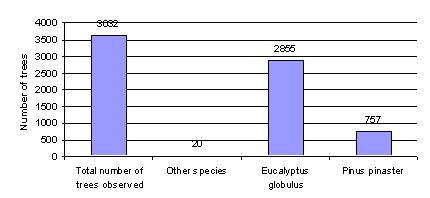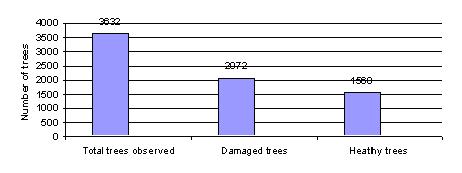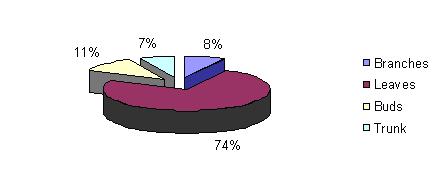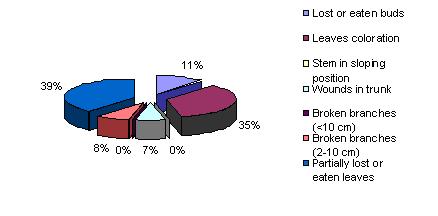4956,1 ha
Percentage of the total
forest area in Sousa Valley: 14,3 %
No of devices: 35
Costs
TOTAL COST: 2068,5 €
Costs/ha: 0,41 €
Costs/device: 59,1 €
The total cost includes:
1- Data collection: 1793,5 €
2- Data analysis: 275 €
Results
Number of trees observed per specie
Source: Field sheets
Damaged and healthy trees in the total of trees observed
Source: Field sheets
Agents causing damages in Eucalyptus globulus
Source: Field sheets
Parts of Eucalyptus globulus affected
Source: Field sheets
Damages in Eucalyptus globulus
Source: Field sheets
*1 device: 4 plots (1 IFN+3 satellites) and 2 transepts (T1, T2).
Remarks
The main species found in FORSEE NFI and satellite plots are Eucalyptus globulus and Pinus pinaster. Some individuals of other species (Quercus suber, Quercus sp. and Arbutus unedo) were also found but only in 2 or 3 devices.
According to data collected during the field work about 2072 trees were damaged (57% of the total of trees observed). As the main specie found was Eucalyptus globulus the data reports the main agents and damages found for this specie.
Concerning Eucalyptus globulus, the agent causing more damages is a defoliator insect identified as being Gonipterus scutellatus and the main part affected are the leaves. The signal which permitted to identify this agent was the attacked leaves, eaten or partially lost.
Other important signal noticed by the field team was leaves discoloration. It was not identified the agent causing this discoloration but one can point out the narrow stand compass which probably put Eucalyptus globulus under intra specific competition for soil nutrients.
Problems and improvements
It is worthy to point out that is very important to assess this indicator in the correct season otherwise agents and damages can not be identified. For instance, the larvae of G. scutellatus eat first the youngest leaves and then the petioles and the oldest ones. The major incidence of this agent happens in the Spring (March, April and May) and in the Autumn (September, October, November).
In North Portugal pilot zone, the field work for health assessment started in the end of March and finished only June, being some devices observed in this month, out of the recommended period to observe this agent. If the decision is to keep the methodology to assess health condition in the device, that is, the NFI plots plus the 3 satellites, one suggests to do the inventory measurements of all NFI plots in a first stage, and then return and to carry out the health assessment in the NFI plots and satellites in a second stage. This way, the period of time for health assessment will not be so large and the evaluation can be done in a shorter period, preferably in the period where more biotic agents can be noticed.
Given the small number of devices where Pinus pinaster was found the results of health assessment for this specie are presented only in FORSEE DATA report. However, it can be added that for this specie, the main biotic agent causing damages is Thaumetopora pityocampa. Given the period of assessment (between the end of March and June) the number of trees where this agent was noticed is minimal. This might have happened because the period was not the right one to observe the processionary moth: the nests are especially visible in July/August and October/November.
Another think to be reported about this assessment seems to be the small notice of damages caused by forest fires in the FORSEE plots. Sousa Valley is a region under a high risk of forest fires, with many forest stands burning every year. As the burned plots and satellites were excluded from the sample, the evidences of damages caused by forest fires were only the observed in the trees that were not very affected.
Comments and conclusion
This indicator allows the manager to know the proportion of healthy and damaged trees, the main agents causing damages and the main parts of the tree affected. However, the manager only will know if it is necessary an intervention if he knows the intensity of the damages.
The importance of forest fires is not well assessed with this methodology for the reasons already referred.
Forest damages (pests and diseases) is one of the indicators of Criterion 2 considered by NP 4406 2003. NP 4406 2003 considers that biotic agents, causing damages in the different parts of the plants are the main agents of forest decline. The fight against pests and diseases doing in advance and using direct measures (biologic fight, sanitarian cuts or traps, etc.) or indirect measures (resistant plants, appropriate forest management, etc.) together with an attitude of surveillance, are indispensable for the management of a good sanitarian condition in a sustainable forest.


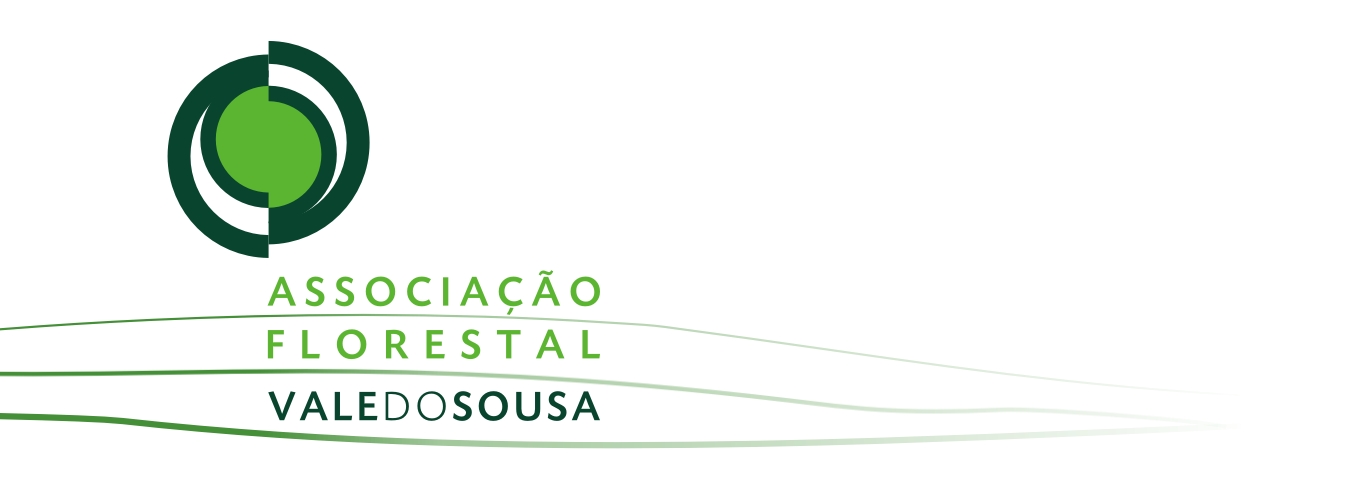

Initiative Communaitaire FEDER
INTERREG IIIB Espace Atlantique
